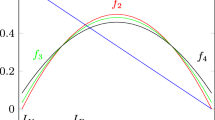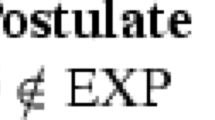Abstract
Explication usually plays the role of the method of language revision. The paper sticks to the Carnapian project of explication and develops some of the formal requirements imposed on the explicatum. However, it departs from Carnap’s view when it comes to how to construe the simplicity condition. It is suggested that in some cases the simplicity condition, which in the Carnapian project plays the derived role with respect to the other three conditions—the similarity, exactness, and fruitfulness conditions—may be substantive for the overall evaluation of explications. Based on a case study of three different explications of the H-D concept of confirmation (provided by Schurz in Erkenntnis 35(1-3):391–437, 1991; Erkenntnis 41:183–188, 1994; Gemes in Philos Sci 60(3):477–487, 1993; Erkenntnis 49(1):1–20, 1998; Sprenger in Philos Compass 6(7):497–508, 2011), we show that there are cases where competing explicata of a common explicandum satisfy the first three conditions equally well. In those cases, then, the simplicity condition is supposed to make the difference. However, instead of using Carnap’s construal of simplicity, we suggest a Principle of instrumental simplicity according to which, ceteris paribus, the simpler the explicatum is, the more likely is its ‘survival’ in competition with other explicata. Moreover, it is suggested that whereas the similarity, exactness and fruitfulness conditions are, in some sense, formal criteria, the simplicity condition is rather tested empirically.
Similar content being viewed by others
Notes
In fact, we can distinguish three different meanings of ‘explication’: (i) the method of explication; (ii) the resulting product of that method; and (iii) a methodological project of using the method of explication as a systematic means for the construction of semantically precise (formal) languages. In what follows I limit my attention to (i) and (ii).
Interest in the Carnapian project of explication is currently being revived. However, sceptical voices have also been raised against the adequacy of explication as a proper method for elucidation of philosophical problems in natural language (cf. Strawson’s 1963; see also Carnap’s reply in Carnap 1963; but currently also by Reck 2012), as well as the critique of the vagueness of criteria imposed on explications (see e.g. Boniolo 2003). For a defence of this method see Maher (2007) and Justus (2012); for a recent analysis of issues related to Carnap’s explication project see the collection of papers in Wagner and Beaney (2012).
That RE is non-transitive means that there are x, y, z such that RE(x, y) \(\wedge\) RE(y, z) \(\wedge\) RE(x, z) and there are also such x, y, z that [RE(x, y) \(\wedge\) RE(y, z) \(\wedge{\sim}\)RE(x, z)].
As Dutilh Novaes and Reck (2017) argue, there is a tension between the similarity condition and the fruitfulness condition, and since the fruitfulness condition is the most important one priority should be afforded to the latter.
In what follows, I will be using the term ‘stipulative’ or ‘codificatory definition’ in roughly this way: “Let expression ‘E’ mean such-and-so”. In essence, a stipulative definition selects a simple or complex expression (the definiendum) and assigns a meaning to it by using other meaningful expressions of a given language (the definiens). To illustrate this point, consider Carnap’s own example with ‘piscis’. The stipulative definition would anchor the explicatum of a given explication as follows: “Let ‘piscis’ mean a cold-blooded vertebrate living in water and having gills throughout life!” For more on definitions see, for instance, Gupta (2015).
In Sect. 3, I provide an illustration of this complexity in terms of three different theoretical explicates. In order to explicate the notion of H-D confirmation, all three explicata depend on the definitions of some key notions (such as the notions of content part or a natural axiomatization of theory).
However, there may be cases of explicata where the identification of fruitfulness is not so straightforward. For instance, the notion of ‘meaning’ (of a certain kind of expression) could be explicated within different semantic frameworks, such as the intensional, hyperintensional or inferentialist semantics. It comes out that what is expressible in one framework is not automatically expressible in another. I am grateful to an anonymous referee for pointing out this complication.
There is also a notion of ‘computational simplicity’ that is applicable to some computational systems such as computer programs or (applications of) some mathematical or formal theories. This notion does not seem to be relevant to the present considerations concerning explications.
However, Kuipers (2000, chap. 2) is an interesting exception. He suggests that his classificatory-cum-comparative view of deductive (H–D) confirmation, based on the so-called comparative principles, can accommodate both the irrelevant conjunction objection and the irrelevant disjunction objection. He accepts that if E HD-confirms H, then both: (i) E HD-confirms \({\text{H}}{\wedge}{\text{H}}\)’ for any H’; and (ii) \({\text{E}}{\vee}{\text{E}}\)’ HD-confirms H for any sentence E’. Nevertheless he argues that the HD-confirmation (or ‘d-confirmation’) is still localizable, and so the resulting paradoxes are not as absurd as they originally seemed to be.
The conditions (i) and (ii) are, in fact, independent.
In fact, this claim may sound trivial, as one anonymous referee pointed out. Nevertheless, even a trivial statement can be used as (partial) evidence (together with other assumptions) for another statement. In what follows, I try to use this claim as part of a general background for arguing in favour of the Principle of instrumental simplicity.
I am grateful to an anonymous referee for raising this objection.
References
Baker, A. (2013): Simplicity. In Edward N. Zalta (Ed.) The stanford encyclopedia of philosophy, (Summer 2015 Edition). <http://plato.stanford.edu/archives/fall2013/entries/simplicity/>.
Boniolo, G. (2003). Kant’s explication and Carnap’s explication: The Redde rationem. International Philosophical Quarterly, 43(3), 289–298.
Carnap, R. (1947). Meaning and necessity. Chicago: University of Chicago Press.
Carnap, R. (1950/1962): Logical foundations of probability. The University of Chicago Press.
Carnap, R. (1963). Replies and systematic expositions. In P. A. Schilpp (Ed.), The philosophy of Rudolf Carnap (pp. 859–1013). La Salle: Open Court.
Dutilh Novaes, C., & Reck, E. (2017). Carnapian explications, formalisms as cognitive tools, and the paradox of adequate formalization. Synthese, 194(1), 195–215. doi:10.1007/s11229-015-0816-z.
Gemes, K. (1993). Hypothetico-deductivism, content, and the natural axiomatization of theories. Philosophy of Science, 60(3), 477–487.
Gemes, K. (1994a). Schurz on hypothetico-deductivism. Erkenntnis, 41, 171–181.
Gemes, K. (1994b). A new theory of content I: Basic content. Journal of Philosophical Logic, 23, 595–620.
Gemes, K. (1997). A new theory of content II: Model theory and some alternatives. Journal of Philosophical Logic, 26, 449–476.
Gemes, K. (1998). Hypothetico-deductivism: the current state of play; the criterion of significance: endgame. Erkenntnis, 49(1), 1–20.
Glymour, C. (1980). Hypothetico-deductivism is hopeless. Philosophy of Science, 47(2), 322–325.
Gupta, A. (2015): Definitions. In Edward N. Zalta (Ed.), The Stanford encyclopedia of philosophy, (Summer 2015 Edition). http://plato.stanford.edu/archives/sum2015/entries/definitions/.
Hanna, J. F. (1968). An explication of explication. Philosophy of Science, 35(1), 28–44.
Hempel, C. G. (1945/1965). Studies in the logic of confirmation. In Aspects of scientific explanation and other essays in the philosophy of science (pp. 3–46). New York: The Free Press.
Hempel, C. G. (1952). Fundamentals of concept formation in empirical science. International encyclopedia of unified science. Chicago: The University of Chicago Press.
Hesse, M. (1970). Theories and the transitivity of confirmation. Philosophy of Science, 37(1), 50–63.
Justus, J. (2012). Carnap on concept determination: methodology for philosophy of science. European Journal for Philosophy of Science, 2, 161–179.
Kemeny, J. G., & Oppenheim, P. (1952). Degree of factual support. Philosophy of Science, 19(4), 307–324.
Kuipers, T. (2000). From instrumentalism to constructive realism. Berlin: Springer.
Kuipers, T. (2007). Introduction. Explication in philosophy of science. In T. A. F. Kuipers (Ed.), General philosophy of science: Focal issues (pp. 7–23). Amsterdam: Elsevier.
Maher, P. (2007). Explication defended. Studia Logica, 86(2), 331–341.
Reck, E. (2012). Carnapian explication: A case study and critique. In P. Wagner & M. Beaney (Eds.), Carnap’s ideal of explication and naturalism (pp. 96–116). Basingstoke: Palgrave Macmillan.
Schurz, G. (1991). Relevant deduction. Erkenntnis, 35(1–3), 391–437.
Schurz, G. (1994). Relevant deduction and hypothetico-deductivism: A reply to gemes. Erkenntnis, 41, 183–188.
Sprenger, J. (2011). Hypothetico-deductive confirmation. Philosophy Compass, 6(7), 497–508.
Strawson, P. F. (1963). Carnap’s views on constructed systems versus natural languages in analytic philosophy. In P. A. Schilpp (Ed.), The philosophy of Rudolf Carnap (pp. 503–518). La Salle: Open Court.
Wagner, P., & Beaney, M. (Eds.). (2012). Carnap’s ideal of explication and naturalism. Basingstoke: Palgrave Macmillan.
Acknowledgements
I’d like to thank to Fredrik Haraldsen, Miloš Kosterec, Theo Kuipers, Marta Sznajder, Jan-Willem Romeijn, Marián Zouhar and two anonymous referees for very helpful comments on an earlier draft of this paper. However, I’m solely responsible for any errors hidden from my view at the moment. This work was supported by the Slovak Research and Development Agency under the contract No. APVV-0149-12.
Author information
Authors and Affiliations
Corresponding author
Rights and permissions
About this article
Cite this article
Bielik, L. Explication, H-D Confirmation, and Simplicity. Erkenn 83, 1085–1104 (2018). https://doi.org/10.1007/s10670-017-9930-2
Received:
Accepted:
Published:
Issue Date:
DOI: https://doi.org/10.1007/s10670-017-9930-2




